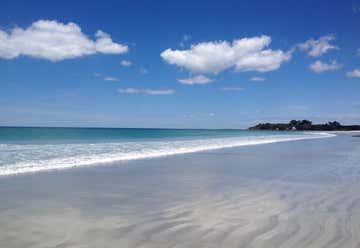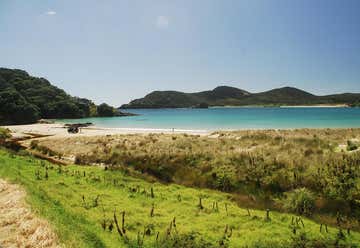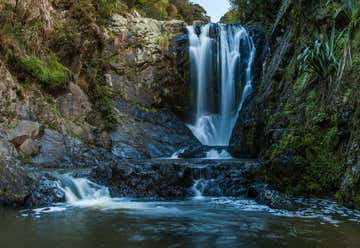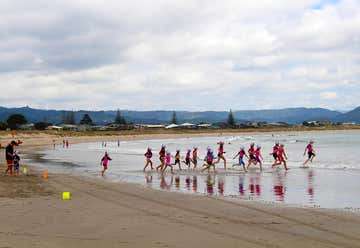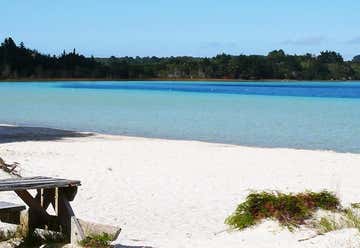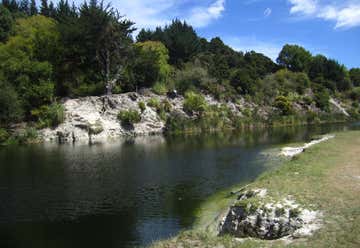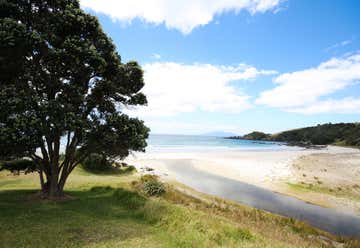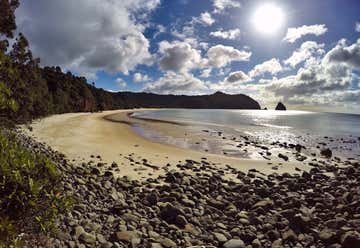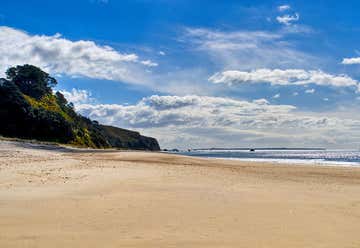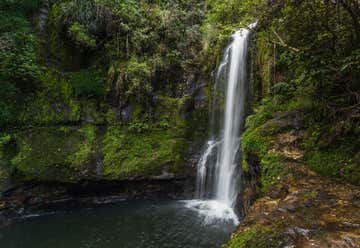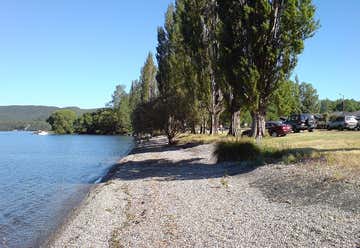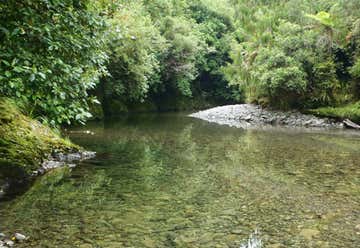Flanked by an ocean and a sea, New Zealand has so many beaches with some famous for their left hand surf break and others as busy as a mall between the flags on a hot summer day. But you don’t have to stick to the edges as inland there are plenty of lakes and wild rivers that are just as good to dunk yourself into, especially the ones that take a little effort to get to, because this is what keeps the crowds away. Here's our top twenty.
If you’re heading to Cape Reinga, then Rarawa Beach is a ridiculously beautiful must stop on the way. The silica white sand is like icing sugar between your toes and it squeaks! And the surf is one long line of fun. Rarawa was where 14 rescued pilot whales swam back out to sea after being rescued at Spirits Bay a few years ago – the largest whale transportation ever attempted. The beach is never too crowded because there’s nothing there but the beach (and a DOC campsite which does get full in summer). The swimming season in the Far North is longer than most because the water doesn’t hit ‘freeze-your-whatevers-off’ quite as quickly after summer, but please remember – it’s not that well signposted and is down a gravel road, so drive carefully and wind up your windows in the summer as the dust gets in everywhere!
Separated by a pohutukawa-coated hill, both of these beaches border on perfection, if there is such a thing in a beach. Both are small and exquisite clamshell shaped beaches with crystal clear, turquoise water so the charm stops you in your tracks when you first see them. With a gentle gradient, they are super safe for swimming, with rocks pools at either end to prod around in. There’s also a large DOC campground if the beauty of it all forces you to stay for the night.
Rangiputa beach, on the other side of Karikari peninsula is blinding with its silica snow-white sand. You can’t go near it without sunglasses on (Puheke Beach is exactly the same with bigger surf)). Popular with freedom campers, you could almost be in Rarotonga on this beach with the soft sand and sub tropical temperatures.
To the east is Mt Puheke, which is a very satisfying climb – and great views at the top (you do need shoes though). New Zealand author, Charlotte Grimshaw described the Karikari peninsula as “a place where barrenness turns suddenly into beauty.”
Any mermaid worth their salt would pick the natural swimming pools at the north end of Matapouri beach to bathe in. Made out of lava rock, the pools are deep enough to dive into (yes!) and only a short but steep walk to get there. Plus Matapouri is a classic golden sand, horse-shoe shaped beach that makes the journey to the pools quite fantastical. After swimming in the pools there are plenty of rocks to dry your salty tail on but make sure it’s low tide or you might find yourself joining the mer-people for good.
When Waipu Cove is chocker full of boogie boarders and surfers or the waves are too ferocious for swimming, then Piroa Falls is a chilled swimming spot (literally). Meaning ‘long headwaters’ in Maori, and just ten minutes through the scenic Waipu Gorge, the misty Falls are always on and always cool. With a few cascading pools at the bottom for swimming in and rocks to clamber over, it can get busy on a hot day so if it’s crowded at the base of the falls there are spots to jump into all along the Ahuroa River. The ten-minute track includes stairs.
Piroa Falls is 6km up the Waipu Gorge Road from State Highway 1 at the foot of the Brynderwyn Hills near Waipu.
Charlie’s Rock used to be a local secret until public access was created a few years ago. Regardless, this place still feels like a special find with its wide waterfall and massive swimming hole on the Waipapa River. Surrounded by smooth flat boulders that rival Stonehenge, and range from 4-12 metres, this an excellent place for testing jumping nerves. And afterwards there are plenty of smooth rocks to lizard about on and warm up again. In summer the water flowing over the waterfall is tepid, which builds up a warm layer in the swimming hole. But please do watch to see where locals jump - just to be safe.
Starting at Cherry Park House and follow the boundary of the Kerikeri Croquet Club before dropping down to the river bank.
The Bay of Islands attracts thousands of people searching for aquatic nirvana and many cram into Paihia or Russell’s main beach, Kororareka Bay. And let them flock we say. But if you’re hankering for some space around your beach towel then leg it over to Long Beach in Oneroa Bay. Twenty minutes of scenic strolling gets you to, as the name teases, a mighty long beach full of golden sand with a safe, sheltered tide, and satisfying views out to the islands. If you don’t care for swimsuits anywhere near your towel then Donkey Bay, around the northern end, is a naturist beach.
With blinding white sand and brilliant blue water that is so clear you really have to call it luminous, the Kai Iwi lakes are impressive. And the best part is that they’re not short stiffeningly cold like many of New Zealand’s lakes and beaches, even in winter. There are shallow parts for those with smaller legs and deep parts, the dark blue areas, for the adventurous. The lakes were blasted into existence 1.8 million years ago and are now a playground for pontoon jumping, kayaking, windsurfing, diving, swimming or lounging around watching it all from a deck chair, surrounded by native forest in the protected Taharoa Reserve.
Abandoned cement works, gigantic disused chimneys, old wells and a deep lake for diving into make a great backdrop for YouTube videos at Warkworth Cement Works. This local spot is an oasis on a steaming hot day and the banks by the river are a good height to get some air when jumping into the lake. The cement works closed in 1929 and have been entertaining locals ever since. They were also used as a location for the 90’s TV series Marlin Bay. Be sure to Google old photos before you go so you can imagine them in their huffing glory nearly a century ago.
Gravel road for part of it: Wilson Road, Warkworth, Rodney, Greater Auckland - turn off Pulham Road into Wilson Road.
When you’re short on time but need to escape the city, Tāwharanui will make you feel like you’ve landed on an island in the pacific. Or at least a peninsula. Anchor Bay is the largest beach at Tāwharanui Regional Park with white sand, grassy knolls, pohutakawa shade and water so clear you’ll be in it in no time. Tāwharanui is the first open sanctuary in New Zealand, which mashes up conservation, recreation and farming successfully, and is home to lots of threatened wildlife, plus it’s a marine reserve. Tāwharanui feels like the Coromandel without the crowds.
1181 Takutu Road, Tāwharanui (gates close at 9pm).
Take State Highway 1 north to Warkworth. Follow the signs to Matakana. Just past Matakana turn right at the Omaha turn off, drive along Takatu Road and the park is well sign posted. (Note: The last 6km of the route is a winding gravel road).
Getting to Motutapu Island by ferry is an adventure but worth it – unless you own a boat. Home Bay is a classic half-donut shape bay and sheltered, making it great for swimming and the pier is super high for jumping off – for kids of all ages. People often camp as you can walk all over the pest free island and spot native birds or imagine yesteryears full of massive Victorian picnics, busy Maori pa settlements, and WWII soldiers hiding in gun shelters protecting the country from invasion. The beach has small, smooth pebbles so sunbathing, cricket, picnics and frisbee all happen on the large, flat grassy lawn.
Ferries operate on weekends and public holidays only.
Onetangi features on lots of Best New Zealand Beaches listicles so you would think it would be standing room only on this north-facing beach but it’s not. With 1.87 kilometres (1.16 miles) of beach there’s room for everyone and the waves are consistently good and safe. Onetangi means ‘weeping sands’ in Māori but the sand is not sloshy, it’s firm enough for the annual Waiheke Onetangi Beach Horse Races and grand sandcastle-building contests. It’s also free of shells so there’s no weeping over slashed toes.
Karekare used to be famous for being the beach where The Piano - Jane Campion was filmed. It’s nearly as famous for the waterfall now. In summer this spot can get busy because the waterfall, at 30 metres high, makes a good backdrop for Instagram selfies and Youtube clips. The walk to the pool at the bottom only takes five minutes but the better, and less crowded plunge pool is at the top. It’s 30 minutes of serious up, but worth it. Especially if you get it to yourself. Afterwards, there’s the mighty (hot!) black sand of Karekare beach to explore.
The Coromandel Peninsula is like the boardwalk of the North Island. Thousands flock there in summer to strut the mighty dunes and frolic in the safer (because it’s the East Coast) lappy waves. The further north you go, the crowds lessen but the roads worsen. It’s hard to pick one beach but New Chums wins for paradise factor. Many get put off by the half hour walk to get there which includes a river crossing and small nikau forest. But once there the famous golden sand, the pohutukawa trees and twinkling ocean really do feel like another world.
Access at the north end of Whangapoua Beach, at the end of a detour between Kuatonu and Coromandel Town. There’s a deep low tide and waters tend to be warm. Ish. This is New Zealand however.
Newdicks Beach will feel totally new to anyone who makes the effort to get there. This raw gem is very secluded down a privately owned gravel road and most locals have no idea it exists. Once there the beach has everything you want on a beach: soft white sand, lush bush surrounds, good waves and a stream at one end for safer swimming for kids. There’s nothing here but the beach: no shops, no toilets, no campsites and no baches, which is why more often than not, there’s also no people.
Town Point Road - $3 fee to drive down the road ($6 for a motorhome) Opens at 6am and closes at 6.30pm in summer, 5pm in winter. Drive from Tauranga to Maketu.
River swimming is generally an uplifting time but swimming at the bottom of good looking, three-tiered falls takes it up to unforgettable. Kaitae Falls cascade over three decent drops and the pool at the bottom, with clear, short-stiffeningly crisp water is worth the fifteen-minute walk to get there. From the car park, a loop track takes you to the top or bottom of the falls. If you fancy a work out up stairs and gnarly roots, then go to the top first (23-30 mins), marvel at the beauty, then follow the path down and reward your efforts with a plunge.
15 minutes south of Papamoa, Upper Papamoa Rd, Tauranga, New Zealand. But please note there are only 14 spots for cars in the carpark.
Most coves and bays around Taupo are refreshing to take a dip in during summer, and being the size of Singapore there are lots to choose from. The trick is finding one that is not full of others also looking to dip or angry swans, annoyed about sharing their bathtub - like the main beach in town. A good option is Kinlock, fifteen minutes east of Taupo, which has a large pontoon for swimming out to with less people and fewer critters. The water is always clear, enticing the most unwilling of bombers to jump. To the left of the bay are rocks for just that (look for the local kids).
James Cook, if he was still alive, might be surprised to hear that Anaura Bay, the beautiful beach he landed on in 1769 and where he met local Māori, is still largely unsettled. There’s no permanent population here which makes the bay feel like that much more of a find. With a DOC campground it gets busy in summer as the weather in Gisborne is usually reliably good. The views from the cliffs at either end of the beach are stunning and make for superb sunrises. But like all Gisborne beaches, take care when the swell is over a metre.
When you hit the last hill before driving down to Ocean Beach you understand how this place got its name. You see a vast amount of ocean on your way down. And once there the ocean view continues with a long stunning beach full of golden sand dunes to lounge in and good waves to swim in. It’s not as busy as the popular Waimarama Beach next door, which is equally long so you’re never actually crowded anywhere on the beach if you don’t want to be, but the waves can be large so stick to swimming between the flags in summer.
And please note, it’s only patrolled in summer.
Kimberly Road Reserve is a secret just off SH57, full of native flora and fauna but not too many of the loud human variety. Running through the park is Ohau River with good flow, and even better swimming holes. There isn’t just one hole that everyone’s trying to jump in so there’s space for everyone. This is the home of the Organic River Festival every February so it’s kitted out with public toilets and plenty of flat grass for lounging or camping on (during summer). It is also safe to exercise dogs here as well.
Please note, you do need a permit to camp, open from December 1st for summer: enquiries@horowhenua.govt.nz.

